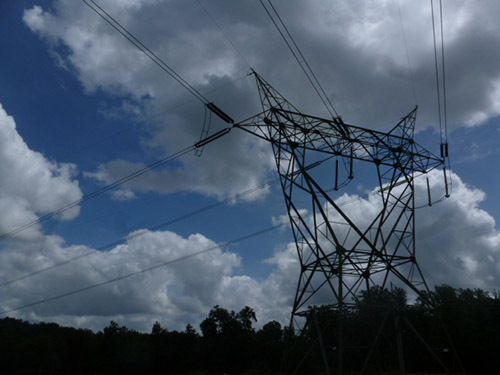
Image: The electricity grid in the wild. Photo by author.
For most of its history in the US, electricity has been a monopoly commodity: in a delimited territory, only one company was legally allowed to produce and deliver electricity to consumers. This state of affairs started to be challenged in the 1970s, when, in accordance with the neoliberal wave, a number of infrastructural services (e.g., airlines, telecommunications) were deregulated, meaning, they were made competitive by law. Electricity followed in the 1990s. First, the Energy Policy Act of 1992 allowed states to break monopolistic utilities into separate production and delivery companies. This act also allowed states to take technological measures to ensure that new companies could plug into the electric grid to sell or buy electricity. And then the Federal Energy Regulatory Commission (FERC) introduced the concept of electricity markets—computational processes through which prices are set for all buyers and sellers, and which are operated by non-profit operators of the transmission grid.
I can’t stress enough the computational nature of these new markets: they exist because the grid is wired up with many kinds of sensors and computational devices that are calculating continuously and zigzagging “information.” Making these markets requires not just economists, but also engineers, programmers, traders, and database specialists—all concerned with making sure that the nature and order of information flows are just right.
Today, economic anthropologists increasingly study market formations. A jolt has certainly been Michel Callon’s 1998 call to study the “performativity” of economics, that is, that economists prescribe markets more than simply describe them.[1] Work in STS has brought the efforts of scientists and engineers to the attention of economic anthropologists, but important questions remain unanswered: how does one account for the work of engineers, programmers, and other experts who don’t necessarily profess allegiance to market ideologies (i.e., they don’t believe that markets are inherently superior to any other form of social organization) and, yet, are often key actors in making markets? Does one have to be a professed neoliberal to build the markets of the neoliberal era? Can the tools of neoliberalism be built into the mathematical and computational machinery of markets? These are questions I have puzzled over through my ethnographic research about electricity markets in the US. Along with my interlocutors, I have come to think of market-making projects as engineering projects emerging out of new communication technologies. From that perspective, the key to locating electricity markets within neoliberalism is the post-War influence of cybernetics on American economics, electrical engineering, and computing.
The “inevitable” electricity markets
The first operator-run electricity market (CAISO) came online in 2000. Six others soon followed; together, they now cover about two million square miles of territory. In today’s competitive electricity landscape, buyers and sellers of electricity submit their carefully calculated bids and offers online to transmission operators’ computers on a daily (and sometimes hourly) basis; then, the next day’s prices are announced (usually in the afternoon). These markets have increased the need for information-processing experts across the industry: traders and market analysts who have programming skills are increasingly sought after.

Image: What the control room of a transmission operator looks like. This room apparently coordinates electricity distribution for all of Ontario. Original here. CC BY-NC-ND 2.0.
Predictably, the politicians who voted in favor of electricity deregulation were guided by political allegiances. After all, the wave of deregulation started under the famously pro-market Reagan administration. As one of my economist interviewees told me, the deregulation of electricity was begun by government officials who thought, “why not deregulate electricity as well? It worked for everything else!” But interestingly, the broad-brush beliefs of such “ideologues” (as my interviewee put it) often do not extend to the actual work of making and running markets. The market designers, market analysts, and electrical engineers among whom I have worked advance the agenda of markets for reasons that are driven more by scientific and technological ideals than economic worldviews.
Often, the accounts of these experts emphasize the technological inevitability of markets. When I interviewed an economist who, in the late 1970s, was part of a group led by an electrical engineer researching algorithmic mechanisms for electricity pricing (which eventually became the basis for spot electricity prices in the 2000s), he cited “technological development” as the reason why the group had come to its research topic so early in the game. By that he meant that their key innovation—pricing electricity differently depending on its source (e.g., renewable versus fossil fuels, given the simultaneously growing research interest in integrating renewable energy sources), as well as the time and location of its delivery—was now both desirable and possible. “Someone would have come up with it, no question about it,” he insisted.
This technological reconstruction of economic goals may be most pertinent to smart grid research. Smart grid is an electricity grid upgraded with digital communication technologies and advanced optimization techniques. Most people are familiar with smart meters—meters that charge real-time prices for real-time consumption—but there is a lot more to smart grids. One doctoral researcher’s project entailed making a market out of one of the still-regulated parts of the electricity business, the fees to use the grid. Whereas the electric grid is currently regarded as a pool where the individual selling and buying cannot be traced after the moment of injection and withdrawal, she proposed novel communication technologies to track sellers and buyers’ use of the grid accurately, in a way that will allow the trading of, not only electricity, but also the rights to the passage of electricity through wires. Echoing my other interviewee, she simply remarked, “the technology is there.” Technology, that is, to bring another realm of economic activity into the domain of competitive markets.
When these experts do make ideological arguments, they are extremely diluted. I recently came across a debate about Texas’s electricity markets, in which one of the parties framed its anti-regulation/pro-market position with the help of a lengthy quote from economist and neoliberal founder Friedrich Hayek. I was excited by this find since I think Hayek’s perspective of markets is extremely pertinent to the smart grid vision. It turns out, though, that all Hayek’s work was was being used for was to let one BP Energy Company dismiss “planning” and praise reliance on “market forces.” Hayek’s 1945 article “The Use of Knowledge in Society,” on the other hand, is far more intricate. It famously depicts a decentralized information system mediated through the “marvel” that is the price. Hayek praises the price as the perfect conveyor of sufficient information and the enabler of coordination across society. Ironically enough, Hayek’s oeuvre itself assumed perfect communication—that prices, the perfect conveyors of information, would travel across society to spread news from the proverbial “man on the spot” seemingly on their own. The communication infrastructure that Hayek assumed to be already in place is an exciting research problem for smart grid researchers, who hope that, through technologies like smart meters, even the regular electricity consumer will become a market actor, who uses dynamically changing prices to make consumption choices.
Hayek hardwired
How then do these non-ideological engineers channel Hayek into the technical infrastructures they build, as they structure more and more economic activity into competitive markets?
My sense (as someone who’s not a historian) is that the contemporary intersection between a Hayekian agenda and the smart grid turn in electrical engineering may be explained historically by tracing the common path through which these disciplines evolved. And that commonality, unsurprisingly, has to do with cybernetics—a short-lived post-War field whose research agenda had “information” at its core. In the postwar era, many sciences have been visited by the information revolution: their core subjects have been reformulated in terms of the circulation of information. According to Philip Mirowski, one of the key actors of the push for economics to leave behind its neoclassical incarnation and become a “cyborg science” that studies the circulation of information was none other than Friedrich Hayek.[2]
On the other hand, electrical engineering’s relationship with the information revolution is roundabout. As David Mindell documents, the early twentieth-century study of the electric grid inspired the construction of computers as well as the study of information processing that culminated in cybernetics and other system sciences.[3] Electricity was, in a way, a “theory machine”[4] for the pioneers of the information revolution, even though the grid remained largely analogue until the appearance of the smart grid research agenda at the turn of the twenty-first century. We may have come full circle: computing and the cyborg sciences that emerged from the grid are being put back into it in order to create competitive markets. Cyborg economics of the Hayekian kind and smart grid research share similar mathematics driven by advanced optimization, which might perhaps explain what I recognize as my interlocutors’ Hayekian language.[*]
While the arrows of causality in this history might be more of a question for historians, there is work for economic anthropologists to do in the meantime, to locate and understand contemporary markets within a mathematical and technological context. Putting software and hardware to the service of market creation, scientists and engineers promote markets as the desirable form of organizing society. It is a promising route for economic anthropology to explore the economic agendas embedded into various scientific and technological research programs—to explore, as it were, the Hayek hardwired into the calculative apparatuses and infrastructures that surround us.
Footnotes
[*] Of course, there is no exclusive relationship between the cyborg sciences and neoliberalism. For instance, Eden Medina’s Cybernetic Revolutionaries tracks a socialistic incarnation of the cybernetic agenda.
References
[1] Callon, Michel. 1998. The Laws of the Markets. Malden: Blackwell.
[2] Mirowski, Philip. 2001. Machine Dreams: Economics Becomes a Cyborg Science. New York: Cambridge University Press.
[3] Mindell, David. 2004. Between Human and Machine: Feedback, Control, and Computing Before Cybernetics. Baltimore: Johns Hopkins University Press.
[4] Galison, Peter. 2003. Einstein’s Clocks, Poincare’s Maps: Empires of Time. New York: W. W. Norton.
Canay Özden-Schilling is a doctoral candidate at MIT’s Program in History, Anthropology, and Science, Technology, and Society (HASTS). Her dissertation project is an anthropological study of the electricity markets in the United States. She focuses on the engineering work that adapts neoclassical economic theories into technological infrastructures and concretizes marketplaces. More broadly, her economic anthropology interests include the dissemination and vernacularization of economics across society.

3 Trackbacks